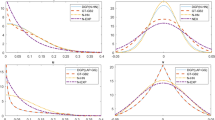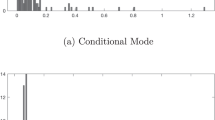Abstract
Stochastic frontier models have been considered as an alternative to deterministic frontier models in that they attribute the deviation of the output from the production frontier to both measurement error and inefficiency. However, such merit is often dimmed by strong assumptions on the distribution of the measurement error and the inefficiency such as the normal-half normal pair or the normal-exponential pair. Since the distribution of the measurement error is often accepted as being approximately normal, here we show how to estimate various stochastic frontier models with a relaxed assumption on the inefficiency distribution, building on the recent work of Kneip and his coworkers. We illustrate the usefulness of our method with data on Japanese local public hospitals.


Similar content being viewed by others
References
Aigner, D., & Chu, S. (1968). On estimating the industry production function. American Economic Review, 58, 826–839.
Aneiros-Pérez, G., González-Manteiga, W., & Vieu, P. (2004). Estimation and testing in a partial linear regression model under long-memory dependence. Bernoulli, 10, 49–78.
Bera, A. K., & Sharma, S. C. (1999). Estimating production uncertainty in stochastic frontier production function models. Journal of Productivity Analysis, 12, 187–210.
Fan, J. (1991). On the optimal rates of convergence for nonparametric deconvolution problems. The Annals of Statistics, 19, 1257–1272.
Fan, Y., Li, Q., & Weersink, A. (1996). Semiparametric estimation of stochastic production frontier models. Journal of Business & Economic Statistics, 14, 460–468.
Hall, P., & Simar, L. (2002). Estimating a changepoint, boundary, or frontier in the presence of observation error. Journal of the American Statistical Association, 97, 523–534.
Horrace, W. C., & Parmeter, C. F. (2011). Semiparametric deconvolution with unknown error variance. Journal of Productivity Analysis, 35, 129–141.
Jondrow, J., Lovell, C. K., Materov, I. S., & Schmidt, P. (1982). On the estimation of technical inefficiency in the stochastic frontier production function model. Journal of Econometrics, 19(2), 233–238.
Kneip, A., Simar, L., & Van Keilegom, I. (2015). Frontier estimation in the presence of measurement error with unknown variance. Journal of Econometrics, 184, 379–393.
Kumbhakar, S. C., Park, B. U., Simar, L., & Tsionas, E. G. (2007). Nonparametric stochastic frontiers: A local maximum likelihood approach. Journal of Econometrics, 137, 1–27.
Liang, H., Liu, X., Li, R., & Tsai, C.-L. (2010). Estimation and testing for partially linear single-index models. Annals of Statistics, 38, 3811–3836.
Martins-Filho, C., & Yao, F. (2015). Semiparametric stochastic frontier estimation via profile likelihood. Econometric Reviews, 34, 413–451.
Meeusen, W., & van den Broeck, J. (1977). Efficiency estimation from Cobb–Douglas production functions with composed error. International Economic Review, 18, 435–444.
Ondrich, J., & Ruggiero, J. (2001). Efficiency measurement in the stochastic frontier model. European Journal of Operational Research, 129, 434–442.
Parmeter, C. F., & Kumbhakar, S. C. (2014). Efficiency analysis: A primer on recent advances. Foundations and Trends in Econometrics, 7, 191–385.
Parmeter, C. F., Wang, H.-J., & Kumbhakar, S. C. (2017). Nonparametric estimation of the determinants of inefficiency. Journal of Productivity Analysis, 47, 205–221.
Speckman, P. (1988). Kernel smoothing in partial linear models. Journal of the Royal Statistical Society Series B, 50, 413–436.
Waldman, D. M. (1984). Properties of technical efficiency estimators in the stochastic frontier model. Journal of Econometrics, 25, 353–364.
Acknowledgements
The author would like to thank two referees for their valuable suggestions, which have significantly improved the paper. Noh’s research was supported by the Basic science research program through the National Research Foundation of Korea funded by the Ministry of Education (NRF-2017R1D1A1A09000804). Van Keilegom’s research was supported by the European Research Council (2016–2021, Horizon 2020/ERC Grant agreement no. 694409).
Author information
Authors and Affiliations
Corresponding author
Additional information
Publisher's Note
Springer Nature remains neutral with regard to jurisdictional claims in published maps and institutional affiliations.
Electronic supplementary material
Below is the link to the electronic supplementary material.
Rights and permissions
About this article
Cite this article
Noh, H., Van Keilegom, I. On relaxing the distributional assumption of stochastic frontier models. J. Korean Stat. Soc. 49, 1–14 (2020). https://doi.org/10.1007/s42952-019-00011-1
Received:
Accepted:
Published:
Issue Date:
DOI: https://doi.org/10.1007/s42952-019-00011-1




